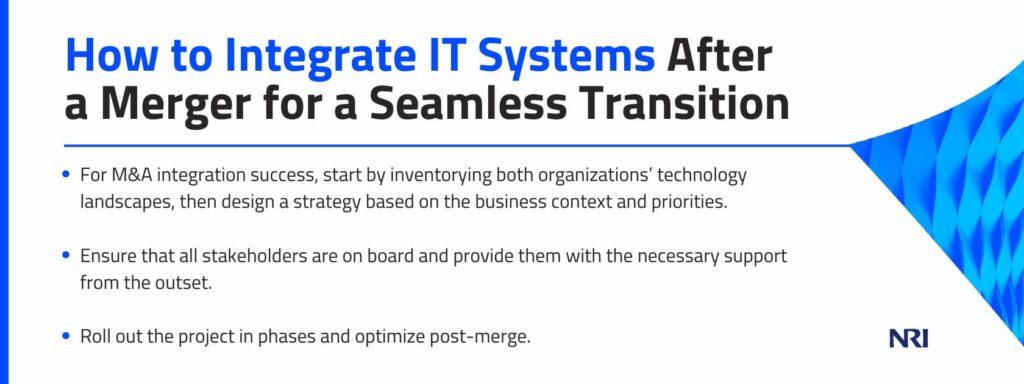Over 85% of M&A integrations fail to deliver significant value. Discover how to position your enterprise for success.

According to PricewaterhouseCoopers (PwC), only about 14% of mergers and acquisitions (M&A) integrations achieve their financial, operational, and strategic objectives. Successful enterprises have a few things in common. For instance, 78% invest 6% or more of the deal value in integration, and 57% fully integrate systems and processes.
According to Ernst & Young (EY), it’s also essential to align the technology plan with the combined company’s long-term business strategy from day one to avoid costly “throwaway” solutions. When IT goals are woven into the overall M&A vision, integration becomes a springboard for growth rather than a drag on value. In contrast, you risk downtime, data loss, compliance issues, user disruption, and other problems without a unified IT environment aligned with your business objectives.
Here’s how to leverage IT as a foundational enabler of business value following a merger.
Assessing Both IT Landscapes
Begin with a comprehensive technology audit.
- What systems exist?
- How are they interconnected?
- Who depends on them?
- What business processes do they enable?
This mapping exercise often reveals unexpected dependencies and integration points that aren’t apparent in organizational charts or standard system documentation.
Also, examine the human and cultural elements embedded within each IT landscape. Organizations have distinct approaches to technology governance, security protocols, and user support models. Understanding these cultural differences early allows you to anticipate resistance points and design change management strategies that acknowledge legitimate concerns while advancing integration objectives.
Next up is a data architecture assessment. Beyond cataloging databases and data warehouses, examine data quality standards, governance frameworks, and integration patterns. For example, are there any long-standing data quality issues that must be addressed in either environment?
Licensing and compliance considerations should also be top of mind. If the organizations have different technology vendors, compliance requirements, and software licenses, these differences can create unexpected cost implications and timeline extensions. Therefore, it is necessary to identify them during the planning phase so that you can optimize your strategy accordingly.
Designing an Effective Integration Strategy
The choice of integration model—whether full consolidation, maintaining hybrid environments, or selective coexistence—should align with broader business objectives. Full consolidation offers the greatest long-term efficiency gains but requires substantial upfront investment and carries higher short-term risks. A hybrid approach offers more flexibility but may introduce ongoing operational complexity, ultimately increasing the total cost of ownership over time. The key is developing selection criteria that weigh business impact, technical complexity, and organizational readiness appropriately for your specific situation.
You can focus first on systems that directly impact customer experience and revenue generation, followed by operational efficiency systems, and finally, administrative and support functions. However, this general guideline must be adapted to your organization’s specific context and risk tolerance. Systems that appear non-critical from a business perspective may serve as foundational dependencies for critical applications, making their integration a prerequisite for other high-priority initiatives.
A phased roadmap with clear success metrics is key to minimizing business disruption while maintaining momentum toward M&A integration objectives. Early wins in less complex areas can provide learning opportunities that inform approaches to more complex integration challenges.
Technical Execution: Key Integration Priorities
The technical execution phase transforms strategic plans into operational reality, and success requires clear priorities and adapting to challenges and opportunities that inevitably emerge during implementation.
Migrating and Unifying Data Environments Securely
Move data in controlled phases. Start with non-essential data or archives, then move transactional data close to the cutover. Use automated tools whenever possible, ensure backups at each step, and continually validate data integrity.
Standardizing Identity, Access, and Security Protocols
Standardize your firewall rules, access controls, intrusion detection, and patch management across the new enterprise. For example, if the two companies had different security postures, consider applying stricter policies or creating new ones across both environments. You can also force a password reset for everyone or require multi-factor authentication at sign-on to eliminate old credentials. Essentially, do everything you can to avoid vulnerabilities or misconfigurations at this stage, as security gaps could expose sensitive data across the merged company.
Consolidating or Harmonizing Core Systems
Regarding system integration, you may need parallel migrations of your enterprise resource planning (ERP), customer relationship management (CRM), collaboration tools, and other core systems. To avoid disrupting day-to-day operations, run systems in parallel while carefully migrating data and users to the new environment.
Maintaining Uptime and Business Continuity During Cutover Periods
Even when technical implementations proceed flawlessly, unexpected issues can arise from user behavior, data anomalies, or environmental factors beyond your direct control. Therefore, solid rollback procedures must be in place to ensure that the business continues to run as usual in the event of any unforeseen circumstances.
Change Management and User Readiness
As IT leaders, we sometimes underestimate the emotional and psychological challenges system changes create for users who have developed comfortable workflows and routines with existing tools. Successful integration requires acknowledging these human factors and designing appropriate change management strategies.
Transparent communication throughout the integration process is crucial. Ensure that impacted stakeholders understand not only what changes are happening but also why those changes are necessary and how they will ultimately benefit from the new environment. Additionally, training and support should be provided to facilitate smooth transitions. Aligning leadership across both organizations is equally critical to drive adoption. When leaders demonstrate unified support for integration initiatives, it sends a powerful signal about expected behavior and organizational priorities.
Post-Integration Optimization
Ongoing monitoring and performance tuning are critical to maximizing the value of your newly consolidated IT environment. Beyond technical metrics like response times and system availability, monitor user productivity indicators, process efficiency measures, and satisfaction scores that reflect the real-world impact of your integration decisions.
Establish regular feedback cycles to capture user experiences, identify process bottlenecks, and surface improvement suggestions that weren’t anticipated during initial integration planning. However, balance responsiveness to user feedback with strategic consistency—not every requested change represents a genuine opportunity for improvement.
Finally, long-term automation and innovation opportunities often emerge from consolidating previously disparate systems and data sources. Keep an eye out for these. However, resist the temptation to pursue every automation opportunity immediately—allow users to stabilize with integrated systems before introducing additional changes that could create confusion or resistance.
How NRI Supports Seamless IT Integration
Integrating IT during a merger can seem daunting, considering all the moving parts. The good news is you don’t have to do it alone. NRI can help you navigate this transition with ease, as we have for many leading organizations in manufacturing, automotive, healthcare, hospitality, education, and other industries over the last 20+ years.
Over the years, NRI has developed comprehensive frameworks and methodologies specifically designed to minimize business disruption while accelerating time-to-value for merged organizations. Our approach emphasizes secure, scalable infrastructure alignment to position your newly merged organization for future growth rather than merely addressing immediate consolidation requirements. This means you can tap into NRI’s expertise from planning through go-live and optimization for your M&A integration, including change management.
Schedule a custom consultation to learn how NRI can support your M&A integration.



